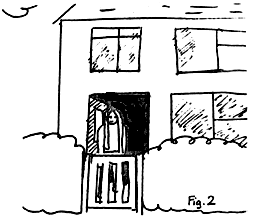You have to correct a yellow cast with a blue filter so I bought 3 from the Cokin range; A23, A24 and A25 (equivalent to 82A, 82B and 82C respectively) I found that the A25 (82C) gave what I considered to be a reasonable white to my eye when viewing on the screen of my Agfa Family monitor (this of course is with the daylight filter in the camera switched OUT, i.e. in the artificial light position – leaving that in will put the orange filter in the camera in the light path and cancel out most of the 82C’s effect!). This is all with Phillips PAR 38 spot lamps (an ordinary domestic bulb with an ES screw fitting).
Different ‘domestic’ bulbs may require different filtration – and different eye sight might have a different opinion on what is white!
Something I have done with no ill effects which I have been warned about is to stop half way through a session of filming and turn the lights off while I go for a break. The colour balance of the lights are supposed to change as they get hotter, meaning that if you turn them off they will cool, and when you turn them on again there will be a jump in white balance (colour temperature) I take breaks turning the lights off with both photofloods and other types and find no discernible jump colour temperature.
I use a +2 dioptres close up lens, which is screwed into the camera filter thread, followed by the Cokin filter holder. My camera does have a macro facility but this operates at the short focal length (so called wide angle) end of the zoom. Were I to try and use it, it would have to be with an animation stand which varied the height of the camera above the artwork in order to frame it (and to zoom). The animation stand I use has the camera at a fixed height and framing is done with the zoom – hence the close up lens. Also, at the wide end of the zoom there is a certain amount of bending of straight lines which would not be all that suitable for photographing artwork in a lot of circumstances.
To set the exposure I put one particular large grey covered book on the stand and take a reading with the cameras TTL metering, my camera having an indicator in the viewfinder which shows the aperture the camera is set to either in manual or automatic modes. Having got the reading I then switch to manual exposure control and set the reading previously indicated by the exposure system manually. This means that the aperture is set and will not alter. Pointing the camera at a grey card (ideally I believe it should be Kodak 182 grey card) or in my case an approximately mid-grey (plain) book cover means that the cameras exposure is set properly since exposure systems are built to average out light coming from a scene as if it were mid-grey. Were you to take the reading from predominantly dark art¬work the camera would over expose, conversely should you take it from light artwork it will under expose. I don’t find working out if artwork is going to average out as light or dark easy, so I use my grey book.
Then comes focusing. I use the cameras split image range finder to focus on a vertical line – although I suspect that my cameras range finder has a slight error in it – by zooming right in and using the range finder I find focus perfectly acceptable.

